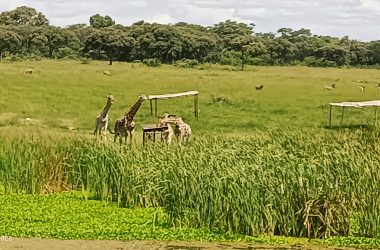By Conrad Mwanawashe
 Land degradation, which threatens the resource base on which most of Zimbabwe’s population depends, is costing up to 6.3% of the country’s Gross Domestic Product (GDP) annually, and this will worsen with climate change.
Land degradation, which threatens the resource base on which most of Zimbabwe’s population depends, is costing up to 6.3% of the country’s Gross Domestic Product (GDP) annually, and this will worsen with climate change.
Zimbabwe is highly dependent on natural resources, including forests, highly variable underground water, and related sectors for livelihoods and economic growth.
However, the country is experiencing high levels of land degradation, costing $112 per person each year in Zimbabwe, totaling $1.8 billion. This excludes the indirect impacts of poor soils such as reduced water supply and declining crop yields.
All of these effects are increasing poverty and food insecurity, according to a new report on Mapping and Valuing Ecosystems in Zimbabwe.
To address these challenges, the World Bank is supporting Zimbabwe to sustainably manage the ecosystem services provided by critical landscapes. The Technical Assistance (TA) funded by the Global Partnership for Sustainable and Resilient Landscapes (ProGreen) entailed a Whole-of-Government collaboration between the Environment Directorate of the Ministry of Environment, Climate, Tourism and Hospitality Industry (MECTHI) and counterparts in the Ministry of Lands, Agriculture, Water, Fisheries and Rural Development.
The TA aims to generate the evidence base for the development of a scaled-up, integrated biodiversity and sustainable production landscapes investment project in the country. A national screening assessment was undertaken to rapidly identify areas in Zimbabwe providing a high level of key ecosystem services that are benefitting communities, as well as areas experiencing, or at risk of significant land degradation.
The assessment expanded on and added granularity to previous mapping of ecosystem services under the Land Degradation Neutrality Framework of the United Nations Convention to Combat Desertification (UNCCD).
 The national screening identified several candidate focal landscapes for more detailed assessment, including the 40,000 km2 Mazowe Catchment north of Harare, which was estimated to provide a high level of ecosystem services and thus good opportunities for conserving and enhancing services provision.
The national screening identified several candidate focal landscapes for more detailed assessment, including the 40,000 km2 Mazowe Catchment north of Harare, which was estimated to provide a high level of ecosystem services and thus good opportunities for conserving and enhancing services provision.
Drawing on the findings of the national-level screening assessment, the selection of the Mazowe Catchment north of Harare as a focal landscape was undertaken by the government, considering its local knowledge of the candidate areas.
“Detailed assessment indicates that productive natural ecosystems in the Mazowe Catchment are being lost and degraded by poorly planned and managed commercial and small-scale livelihood activities, and the threats will be further exacerbated by climate change,” the World Bank report notes.
The catchment lost over 1,100 km2 of its dense woodland and over 400 km2 (90 percent) of its wooded grassland, mostly to dryland cultivation, in the last 25 years.
Cropland expansion, fuelwood harvesting, and illegal mining associated with poverty, population growth, and lack of secure property rights are the major drivers of land degradation. Cropland extensification as the main strategy for increasing food production, land scarcity and poor land management practices lead to high erosion rates, particularly in communal areas, contributing to water quality and sedimentation issues.
Population pressure has also increased the harvesting of firewood and other natural resources and worsened grazing pressure on the increasingly small areas of remaining grazing land.
Climate change could contribute to significant reductions in crop yield due to greater heat stress and more erratic rainfall patterns. Climate change is expected to reduce groundwater recharge and surface runoff in the Mazowe Catchment.
Although this is expected to be moderate relative to other areas in Zimbabwe, water availability for agriculture and domestic use will be negatively affected by increased evaporation losses and unreliable rainfall patterns.
The TA also reveals that the ecosystem services supplied by natural ecosystems are more valuable than the agricultural production value of cultivated areas.
Some of the policy actions to support effective scaling up of sustainable landscape management include:
(a) Support the upscaling of CSA interventions in the Mazowe Catchment following the recommendations of the Zimbabwe’s CSA Investment Plan (CSAIP) which aims to strengthen the country’s agriculture sector’s resilience to climate change.
Priority investments recommended by the CSAIP include on-farm investments in improved crops, fertilizers, irrigation, and animal management to increase farmer production and build resilience; off-farm investments in storage, processing, marketing, and research & development to increase the agricultural value chain’s productivity and efficiency; and cross-cutting investments in land reform and water management to help the country realize its full agricultural potential.
(b) Invest in Sustainable Forestry Management (SFM) across the Landscape. The high rate of deforestation observed in this study requires investment in sustainable forest management to maintain the health and integrity of forest ecosystems, conserve biodiversity, mitigate climate change, and provide livelihoods for communities that depend on forests.
Investing in sustainable forest management will also help conserve ecosystem services, provide social and community benefits, and align development efforts with the growing trend of green investments and impact investing for a green economy. Key investments for consideration in this regard include reforestation and afforestation of severely degraded land, conversion, and passive reforestation of marginal agricultural land into silvo-pastoral systems for adapted livestock species or community conservancies.
Feedback: [email protected]









